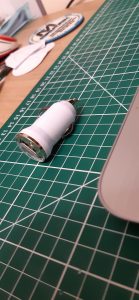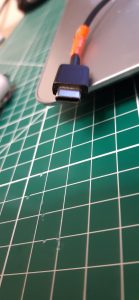If some newspapers are to believed, we could be facing power cuts when energy workers increasingly become ill. In these times of self isolation, we are becoming increasingly dependant on our Smart Phones and Laptops to keep in touch with friends, family and news as well as other DSSC members. With Smart Phones needing a recharge each day and laptops needing a charge after about 3 – 6 hours, an extended outage could be problematic. However, RC modellers are a resourceful bunch so all is not lost. Most modern tech can be powered or charged from a USB source.
Our car 12v accessory socket or as I still call it – the cigar lighter socket can power a USB adaptor. I have one as shown that will accept a variety of USB leads to suit different phones. Some recent cars will also have a USB socket that can recharge. I know the engine will probably need running but the heat may be useful to grill a rasher or two.
When it comes to the laptop, many current models will have a USB type C socket to take the small oval USB plug as shown below. The USB-C port / socket can be used to power or charge the laptop (the original USB-A on your laptop will not do that). So again the car can provide some power and perhaps fry an egg.
This is where us electric guys have some alternative power sources – our LiPo’s. A UBEC can normally output 5V from a range of LiPo voltages (the ones I looked at today went from 2S to several S’s) to power the receiver but as 5V is the same as USB voltage, so with a bit of soldering to a USB lead with the appropriate plug / socket on the other end of the lead and a connector to match your battery pack – we have power for our phones or laptops. You may prefer to keep the servo connector on the BEC for the future and make up a servo socket to USB lead adaptor.
The easiest way to to connect a USB plug or socket is to cut an existing lead and connect the red and black wires (via the servo adaptor) to the output from your UBEC. If it is not clear which are the 5V and gnd wires, use a multi meter to check against the USB outer pins next to the casing. Remember test that you have the correct polarity and 5V voltage before connecting your tech.
Like all helpful suggestions – do this at your own risk and have a look around YouTube to see how others have done this.
